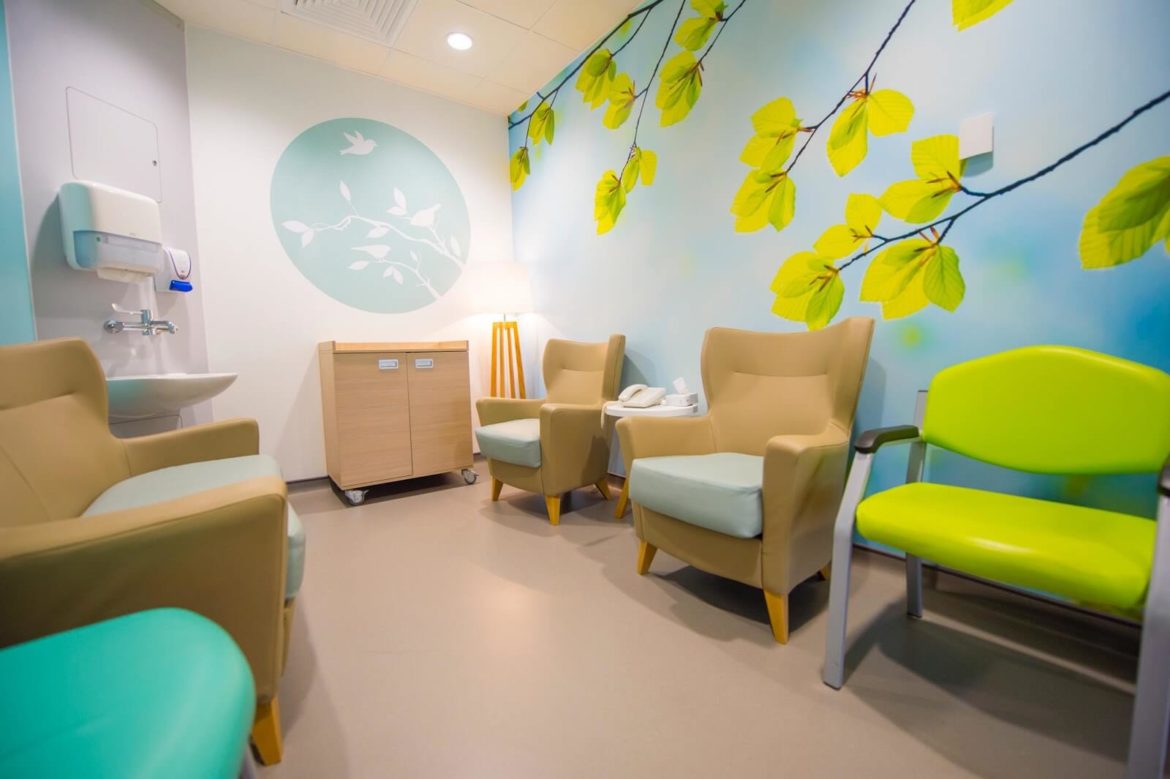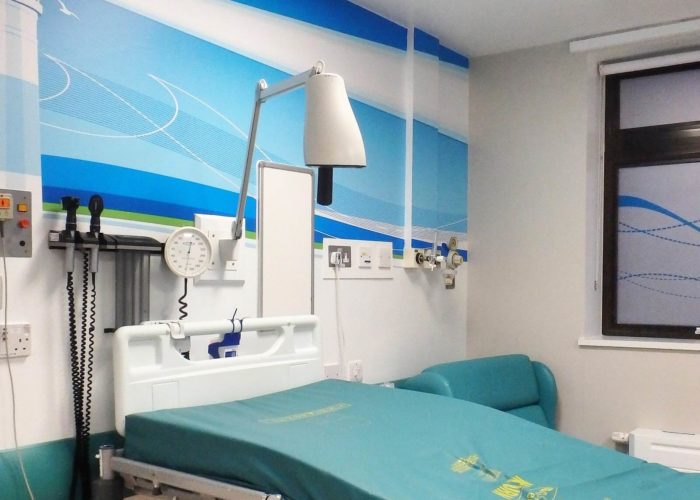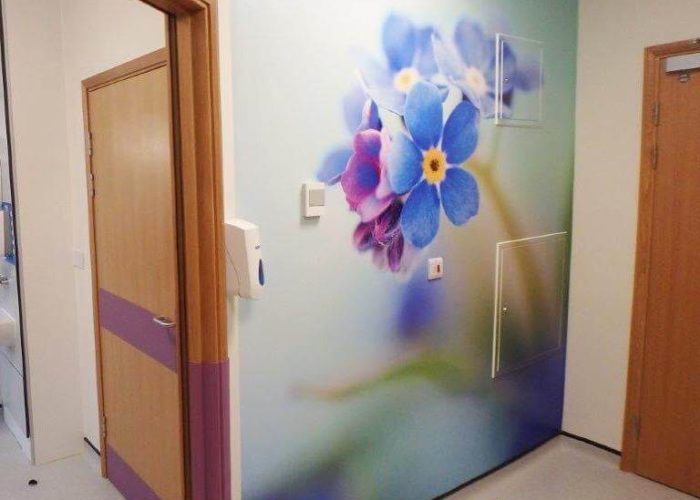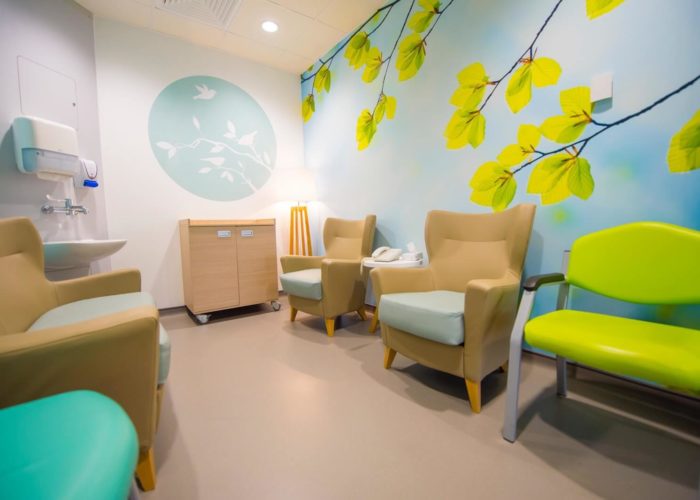
By the time you’re an adult, you normally have a good idea of what a typical hospital looks like, whether it’s from visiting friends and family, spending time there yourself or even from films and television programmes. Usually, they all tend to have the same features that make a hospital look like a hospital; long corridors that consist of bare and beige walls, furniture that’s seen better days and posters and print outs that are clinging to the walls of wards.
But as well as being a place where patients can receive medical care, we think that a hospital should be a place that supports your wellbeing. So, what can we do to ensure that a healthcare environment that we design will help to promote a patient’s journey back to health as well as facilitate it?
Calming colour schemes
When we’re considering how we can create an environment that supports the wellbeing of the patients who will be using it, we give a lot of thought to the colours that we use in the design. Colour psychology is by no means a new concept but the benefit of this is that there’s a great deal of research into how different colours can affect mood, emotional health and wellbeing.
When we select a colour scheme for a particular ward, we always want to pick one that is sensitive to the emotional needs of the patients, while reassuring them at the same time and even helping them feel confident in their treatment and their own personal journey back to health. Conversely, we always want to avoid using colours that will startle, scare or make patients feel fearful or worried.

Colours inspired by nature like sea blues or forest greens have calming qualities and can form the base of a considerate colour scheme, however it’s also important that the accent colours of other surfaces like floors and furniture complement this base and don’t create a visually stressful clash of shades.
It’s really important for us to consider the clinical implications when we’re using certain colours within hospitals. For instance, psychologists have long subscribed to the idea that yellow is a colour that lifts mood and as ideal as this sounds for a hospital where we want patients to feel happier, practically speaking, it is likely to be a hindrance to hospital staff who need to check the colour of patients’ skin for signs of discoloration.
Images inspired by nature
As well as colours inspired by nature having a positive psychological impact on patients, images which depict calm scenes in natural settings can also be of great benefit. One study conducted in the US found that an indoor environment that felt linked to the outside world was one of eight key things that patients and families looked for in a hospital environment.
Wall Art, a tool we often use to transform wards, together with a vast bank of images, gives us virtually endless opportunities to bring the outside in, helping us to create a more positive environment in which patients can continue on their journey back to health.

Nature can also be a positive influence for those patients who are on a very different kind of journey; those who are receiving palliative care. Tranquil images and abstract elements inspired by the natural landscape can help to create an environment that is more welcoming and reassuring for both patients and their families as they go through some of the most difficult days of their lives.
LED Sky Panels
One of the biggest elements within nature and the outside world that has a positive impact on the emotional wellbeing of hospital patients, and people in general, is the sun. You only have to look around on a sunny day to see that everyone seems happier. There’s also an ever-growing body of research which confirms the positive influence of natural sunlight on our mood and, in contrast, into conditions such as Seasonal Affective Disorder that are exasperated through the winter months when daylight hours are minimal.
of the biggest elements within nature and the outside world that has a positive impact on the emotional wellbeing of hospital patients, and people in general, is the sun. You only have to look around on a sunny day to see that everyone seems happier. There’s also an ever-growing body of research which confirms the positive influence of natural sunlight on our mood and, in contrast, into conditions such as Seasonal Affective Disorder that are exasperated through the winter months when daylight hours are minimal.
Being in hospital often means that patients miss out on seeing sunshine and daylight, especially those who are unable to leave their beds. Eventually, this may contribute to feelings of claustrophobia and frustration as well as low mood which, in turn, can affect how well they respond to those who are providing their care and the treatment itself.
To help combat this, we use LED Sky Panels to help bring some of the blue skies and sunshine of a bright summer’s day inside for patients who can’t experience it outdoors. While it isn’t quite the real thing, the ceiling panels can help to relieve those feelings of frustration that can understandably arise in inpatients and reduce the risk of them becoming less responsive to their treatment.
Designing spaces that benefit visitors as well as patients
As well as creating wards that support those who are in hospital as patients, it’s also important for us to create spaces that support the wellbeing of friends and family who are accompanying them too.
When we’re looking at areas like quiet rooms and relative rooms, we always try and create a sanctuary away from the rest of the comings and goings of a busy hospital; a sanctuary where they can come to terms with a situation that is inevitably emotional and often incredibly difficult.
We take the design details that we use to create more supportive clinical environments, things like considerate colour schemes and carefully chosen Wall Art, and apply them to spaces like quiet rooms to create a comfortable and comforting space for friends and relatives of patients to be afforded a little respite for themselves.

Hospitals play a big role in ensuring that those patients that need to receive medical treatment are able to receive the best care possible. But healthcare environments also have the potential to do more than just be a dedicated space for patients to get better, they can help them to experience a more positive healthcare journey which, in turn, can enhance treatment outcomes for patients and aid them in their recovery.
If you want to know more about how we are helping wards to become better healthcare environments for patients, get in touch or subscribe to our newsletter to be sent the latest news, ideas and inspiration for better ward design.
